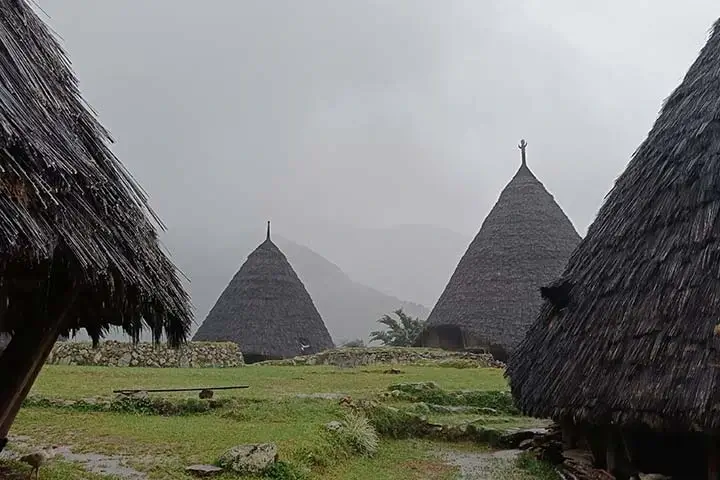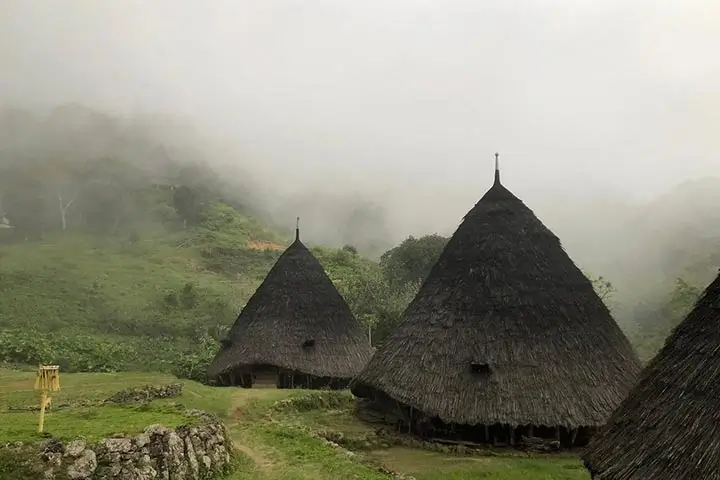Wae Rebo Village;
a Glimpse about
Unique Cultural Heritage
in Manggarai, West Flores
Top Joyday Tour




Wae Rebo Village is situated at an altitude of about 1,200 meters above sea level. The Village surrounded by dense forests and mountains. Nestled in the lush highlands of Manggarai Regency in West Flores, Wae Rebo is a picturesque traditional village that offers a glimpse into the unique cultural heritage of the Manggarai people. Known for its distinctive conical houses and breathtaking natural surroundings, Wae Rebo has become a symbol of Indonesia’s rich cultural diversity and resilience.
How to Get to Wae Rebo village
Wae Rebo Village can be reached in 5 hours by car from Labuan Bajo town to the car parking area in Denge Village. Then from the Parking area, start trekking through a dense forest to reach the village.
It is truly a beautiful and amazing challenge when you successfully reach this traditional village. Your trekking will take around 3 to 4 hours to reach Wae Rebo village. There are 5 rest stops on the hiking trail. You will stop for a moment at each of these posts while breathing in the fresh natural air.
The chirping of various types of wild birds also accompanies you throughout your journey. This natural sound is like a good relaxation and healing energy from the hustle and bustle of the city and the density of your work.
Upon your arrival to the village, all the tiredness and aches from trekking will be cured by the natural scenery and uniqueness of this village. The remote location of Wae Rebo has helped preserve its traditional way of life, relatively untouched by modern influences.
When is the best time to visit Wae Rebo village
If you are interested in visiting Wae Rebo Traditional Village, determining the right time to visit is one of the important thing. Considering the location of Wae Rebo which is in the highlands with quite long rainfall in the rainy season, we suggest you visit this traditional village in the dry season (April to September).
Based on our previous experiences, sometimes during the rainy season, tour activities to the traditional village of Wae Rebo are closed. This happens if there is a landslide on the path to this destination. This is for the comfort and safety of your tour. Of course, this is very unpleasant if you have carefully planned a trip to this village and finally get here and it is canceled because the weather is not supportive and the tourist attractions are closed. Therefore, it is also highly recommended to communicate with us as local people or local agents here regarding weather conditions and the current state of the tourist attractions you want to visit.
History and Heritage of Wae Rebo Village
The village of Wae Rebo is believed to be around 100 years old, founded by the Manggarai people who migrated from other parts of Flores. According to local legend, the ancestors of Wae Rebo were guided by the spirits to this secluded spot, where they established a community based on harmony with nature and adherence to traditional customs. The villagers continue to practice ancient rituals and ceremonies, maintaining a strong connection to their ancestors and the land.
The Iconic Mbaru Niang Houses

Wae Rebo is renowned for its unique Mbaru Niang houses, which are traditional cone-shaped structures made of bamboo, wood, and thatch. These houses are not only architectural marvels but also serve as communal living spaces where extended families reside together. The design of the Mbaru Niang is both functional and symbolic:
- Structure: Each house stands on a circular base with a high, conical roof that reaches up to 15 meters in height. The roof is made from palm thatch, which is meticulously arranged to ensure durability and protection from the elements.
- Levels: The interior of the Mbaru Niang is divided into five levels, each serving a different purpose. The ground level is used for daily activities and communal gatherings, while the upper levels are used for storage and as living quarters. The topmost level is considered sacred and is reserved for ancestral offerings and rituals.
- Symbolism: The architecture of the Mbaru Niang reflects the Manggarai cosmology, with the circular base symbolizing the earth and the conical roof representing the sky. This design underscores the villagers’ belief in the interconnectedness of the physical and spiritual worlds.
Cultural Practices and Traditions in Wae Rebo Village
- Agriculture: The villagers rely on subsistence farming, cultivating crops such as coffee, taro, and vegetables. They also practice traditional methods of animal husbandry.
- Rituals and Ceremonies: Wae Rebo is known for its vibrant rituals and ceremonies, which mark important life events, agricultural cycles, and communal celebrations. These rituals often involve offerings, dances, and songs that have been passed down through generations.
- Craftsmanship: The villagers are skilled artisans, creating intricate woven fabrics and traditional handicrafts that are both functional and decorative. These crafts are often sold to visitors, providing a source of income for the community.
Preservation and Sustainable Tourism
In recent years, Wae Rebo has gained recognition as a cultural and tourist destination. Efforts to preserve the village’s heritage have been bolstered by both local and international support. Key initiatives include:
- Cultural Preservation: Organizations and government agencies have worked with the villagers to restore and maintain the Mbaru Niang houses, ensuring that traditional building techniques are preserved.
- Sustainable Tourism: To manage the impact of tourism, the community has developed guidelines that promote sustainable practices. Visitors are encouraged to respect local customs, participate in cultural activities, and contribute to the preservation efforts through entrance fees and donations.
- Education and Awareness: Programs aimed at educating both locals and tourists about the cultural significance of Wae Rebo have helped raise awareness and foster a sense of pride among the villagers.
Wae Rebo stands as a testament to the enduring cultural heritage of the Manggarai people. Its remote location, unique architecture, and vibrant traditions make it a living museum of Indonesia’s rich cultural tapestry. As efforts to preserve and promote Wae Rebo continue, this traditional village will undoubtedly remain a cherished and inspirational destination for generations to come.

Explore Flores Island: A treasure Trove of Natural Wonders and Diverse Cultures
Flores Island, part of the Lesser Sunda Islands in Indonesia, is a destination that captivates visitors with its diverse landscapes, rich culture, and unique wildlife

Homo Floresiensis - The hobbit from Flores, Indonesia
The discovery of a small, ancient human species on Flores Island in Indonesia has captivated scientists and the public alike, providing unprecedented insights into human evolution.

Kelimutu Tricolor lake: Unlock the Mystical Tricolor Lakes
Kelimutu National Park has become a popular destination for both domestic and international tourists, drawn by the breathtaking beauty and mystical aura of the tricolor lakes.

Riung 17 Isles Marine park
Riung 17 Isles Marine Park is fringed with powdery white sand beaches, crystal-clear turquoise waters, and lush mangrove forest. The surrounding coral reefs are teeming with marine life, making it a haven for snorkelers and divers